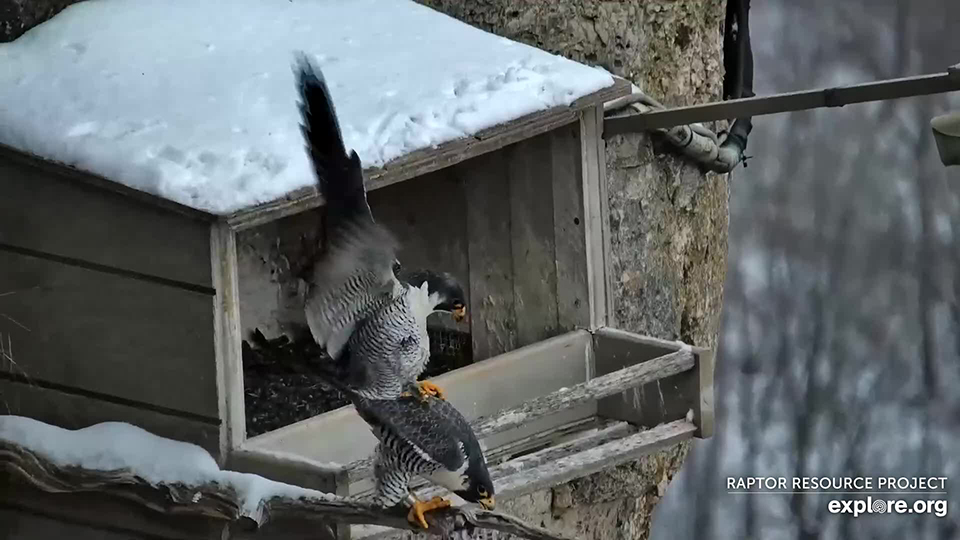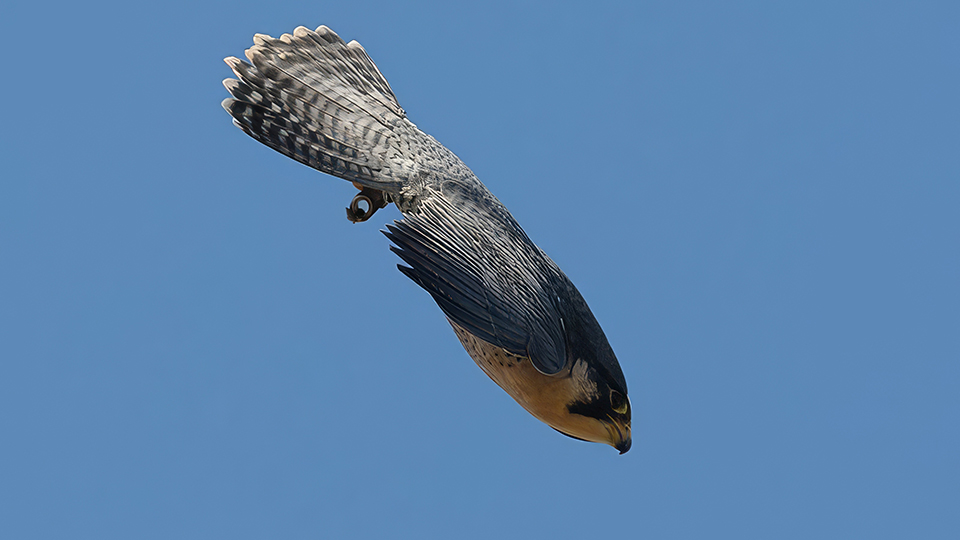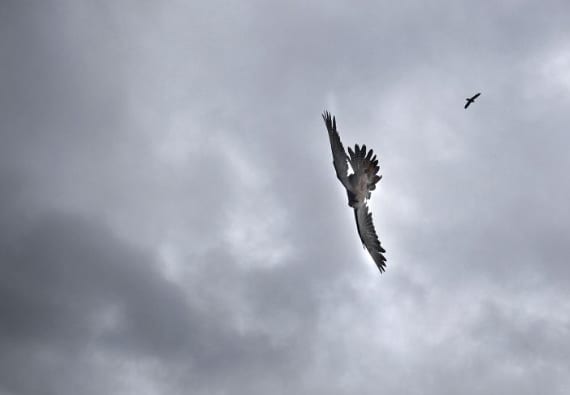Egg-laying is just around the corner for our peregrine falcons! The earliest layers – Great Spirit Bluff is usually among them – tend to begin in late March, although egg-laying can continue into late May at some of our nests. So when should we look for eggs at Great Spirit Bluff? It depends on a number of factors, including territorial competition, species and individual chronology, nesting experience, and mating history.
 March 22, 2024: Acrobatic Falcon love!
March 22, 2024: Acrobatic Falcon love!
Falcons usually begin returning in mid-February. Territorial competition can occur almost any time of the year, but peaks in March and early April when hormones are running high, falcons are returning from migration, and a new crop of adults is suddenly feeling the urge to nest. Once adult falcons have sorted themselves into breeders and non-breeders, territorial competition subsides. We also don’t know when Lisa – assuming she wins Newman’s rose, of course – will lay eggs. If we look at past female falcons here:
- Michelle, the resident female when Newman took the nest, usually laid her first egg between March 27 and April 2nd. She began nesting at GSB in 2011 and was fairly predictable.
- Nova, Newman’s second mate, laid her first egg on March 26, although she only nested one year.
- Zooey, Newman’s third mate, laid on April 16th her first year, but moved back to April 3 her second year. This is a pretty typical pattern in first-time layers. Intense territorial competition and age – Zooey was a brand new adult – might also have pushed her first year back.
- Savannah, Newman’s fourth mate, laid her first egg on March 29. She was killed by an owl in June of 2023.
So within certain parameters – falcons at this latitude usually lay eggs between the last week in March and some time in mid-April – falcons can vary quite a bit. We don’t know anything about Lisa other than her age, which makes it very hard to predict a laying date. But we can watch for signs of incipient laying, including lethargy (more time in the nest box and on the perch), eggnancy (large, oblong abdomen and ‘bedhead’ vent feathers), and false labor: squatting over the scrape as though in egg labor, absent contractions and eggs.
Aren’t Peregrine Falcons Monogamous?
Like bald eagles, peregrine falcons were long considered to be monogamous. It’s more or less true if your idea of monogamy includes deadly mate competitions, winner take all. Imagine: you’re eating breakfast with your spouse. A stranger shows up, decides your house and spouse look great, and tries to kill you or chase you away. Instead of helping defend you, your spouse stands back. Whoever wins gets breakfast in bed…with me!
A territorial falcon doesn’t usually get the chance to ‘cheat‘, because interlopers aren’t welcome and falcons fiercely defend their territories. But as we’ve seen before, Newman is more than happy to copulate with visiting female falcons, established mate or no. Bob believed that peregrine falcons were bonded first to place and secondly to mates, which is exactly what we’re seeing at Great Spirit Bluff.
TLDR: peregrine falcons are mostly monogamous, but not as we think about it. Extra-pair copulations, aka cheating, is fairly rare, although non-bonded pairs sometimes get together, especially during migration. Polygyny is even rarer – we’ve only seen it once among our birds – and I am unaware of any documented cases of polyandry in peregrine falcons.
What’s Going on At Great Spirit Bluff?
Why are so many female falcons showing up at the bluff? Males come back from migration earlier than females. They set up territories and attract the ladies with fancy flying, vocalizations, and food gifts. Great Spirit Bluff has everything a falcon could want: it’s high, well-protected, swarming with food, and has a handsome male falcon who’s pretty good at food gifts. Female falcons are checking it out, Newman is courting all of them, and we are at peak return time! Lisa will continue to chase the interlopers off and most breeding adults will have settled into a territory by late March, so it won’t be long until this season’s The Bird Bachelor concludes.
As we’ve seen in other years, two of the three females we’ve seen this year were both been spotted here before. Lisa, the current rose holder, was spotted at GSB in the spring of 2023 and Julie 90/Z made a brief appearance last fall.
In Flight
The Peregrine Falcon is the fastest animal in the world, diving or stooping at speeds that can reach over 200 miles per hour. Almost everything about it is built for speed, from the baffles in its nose to the jagged edges of its slim, stiff feathers and long, pointed wings.
A Peregrine Falcon catches other birds in flight by diving on them from above. As she begins her stoop, she rolls, cups her wings around her body, and tucks in her feet. This change in shape streamlines her profile, yielding an aerodynamic raindrop that can cut through the air at high speeds.
 Peregrine Falcon in a stoop. Photo by Alan Benson.
Peregrine Falcon in a stoop. Photo by Alan Benson.
As she plummets, her nictitating membrane protects her eyes from dust and debris in the air and a secretory gland helps keep her corneas from drying up. A special cone or baffle in her nose regulates the amount of air entering her nasal cavity, allowing her to breathe and protecting her from damage. A curved flight path keeps her prey in view and allows her to respond to last-minute escape attempts without losing lift. Before she strikes her prey, she’ll experience G-Forces estimated at between 25-27 Gs.
The peregrine meets her prey feet-first. She slows first, unfurling her wings and tail, and dropping her feet. After striking and stunning or killing it outright, she’ll loop around in mid-air to retrieve it and take it to a safe place for plucking and eating.
 Falcon Belinda at Xcel Energy’s Allen S. King plant takes aim at a reporter
Falcon Belinda at Xcel Energy’s Allen S. King plant takes aim at a reporter
Lifestyles of the Fast and Furious
Falcons are roughly crow-sized. Females are about a third larger than males, although they both have blu’ish to slate grey backs, barred or streaked white to rusty underparts, and a dark hood. Adults have black beaks and yellow feet, although their babies may initially have bluish feet. This is natural and not a cause for alarm.
Both males and females are highly territorial. We believe that they are fairly solitary birds even off their nesting grounds, although groups of young peregrines have been reported on oil platforms and ships in the Gulf of Mexico. I would love to see more studies on their ‘wandering years’ and wintering grounds. We know very little about their behavior off-territory.
Traditionally, Peregrine falcons nest on cliffs, laying their eggs directly on a scrape they created in a gravel or sandy substrate. In the Midwest, Peregrine falcons generally:
- Lay eggs in late March or early April
- Hatch in late April to early May, or 33 days after the first egg is laid.
- Begin flying in mid-June or later, or about 40 days after hatch.
Peregrines are excellent, attentive parents. The babies cannot thermoregulate (control their temperature) until they are about 10 days old, so Mom spends a great deal of time huddling over them while Dad feeds everyone. As the babies age, both parents spend time hunting. The eyrie is small and the babies, which have among the fastest growth rates in the animal kingdom, are large and hungry. They eat, sleep, poop, and go from white fuzzballs to sleek brown juveniles in 38-40 days.
Once they begin flying, young peregrines spend a lot of learning how to fly and hunt: something that looks a lot like play to most human observers. Their parents will continue to provide some food for their newly fledged young who are not yet self-sufficient. Come fall, the adults may or may not migrate, but their children will disperse between mid-July and early September. Once they are gone, they are gone. If they do come back to the nest, their parents will defend it from them.
What to expect when falcons are expecting
You can watch for peregrine falcon courtship at any of our nests, although Great Spirit Bluff is my favorite! Watch for fancy flying (the male or tiercel falcon flies acrobatically, sometimes wiggling his tail as he goes), bowing, scraping, and incredible fly-in copulations. Males will gift females with food, and both sexes will work on a scrape, digging into the gravel with their breasts and pushing with their legs to create a depression into which the female will lay her eggs. Falcons do not create tree nests, although they have been documented laying eggs in unused Bald Eagle nests.
Female falcons will begin laying three to four reddish speckled eggs sometime in late March or early April. Peregrine falcons do not begin full incubation until after egg number three is laid, so it is normal for them to spend time – even quite a bit of time, depending on how warm it is – away from eggs number one and two. Eggs should begin hatching roughly 33 days after the third egg is laid.
During incubation, falcons experience hormonal changes that help keep them incubating. They may appear sleepy or lethargic as they pick at gravel and sit on their eggs. Females do most of the incubation, although their mates will spell them briefly during the day. Smaller males sometimes have a harder time covering all of the eggs, depending how many are laid. We can also expect to see egg rolling and some shimmying. This is not a particularly active time for the falcons: Bob used to refer to incubation as the ‘egg doldrums’. Keep your eyes open – we should be seeing eggs at GSB soon!
 The Raptor Resource Project
The Raptor Resource Project The Raptor Resource Project
The Raptor Resource Project